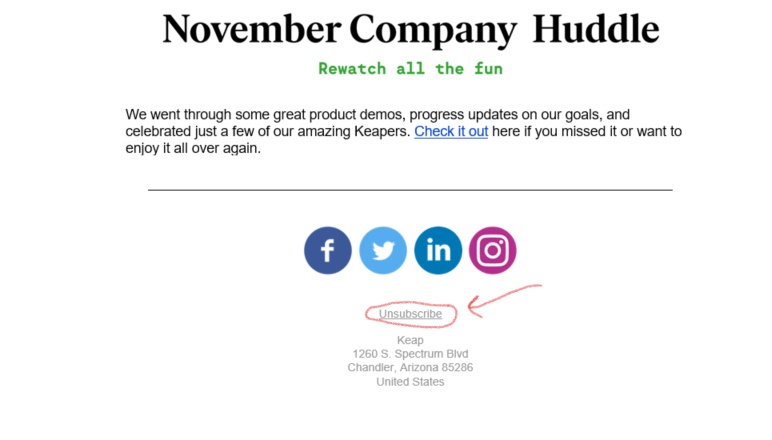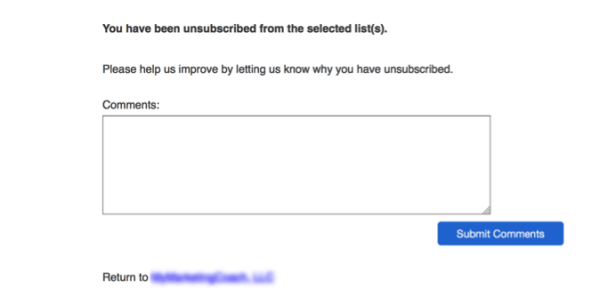Any company that’s in the habit of sending emails to their clients is certainly no stranger to unsubscribes.
There are many reasons people opt-out of receiving your content, so it’s best not to take it personally and to make it as easy as possible for them to unsubscribe. The easier you make it on them, the better lasting impression they’ll have of your company, possibly even inspiring them to keep in touch in a different way, such as following you on social media. Sometimes “goodbye” in this sense could simply mean “see you later.”
Improving your unsubscribe process may result in more people changing their minds and not wanting to leave after all.
Paradoxically, adhering to the best practices below may very well result in email list growth.
1. Include a clear email unsubscribe message
This isn’t about email etiquette—it’s the CAN-SPAM law. You have to create a way for your subscribers to opt-out.
There are many different unsubscribe email templates that include an easy-to-find unsubscribe link in the footer. Don’t bury it or make it impossible to find, that could further infuriate an already frustrated audience.
Make it highly visible like in this opt-out email example from Keap below. Notice how the “Unsubscribe” link is nicely isolated and easy to find in the footer.

2. Know the unsubscribe laws and follow them
Speaking of the CAN-SPAM law, per the U.S. CAN-SPAM, companies are required to keep the unsubscribe links working for 30 days. The Canadian CASL requires unsubscribe links to work for at least 60 days after an email message is sent.
3. Let them “opt-down”
In addition to unsubscribing, let your subscribers set how frequently they want to hear from you so they feel like they’re in control. People may still want to get your emails, just not every day.
You can direct them to an “update your preferences” link such as the one below:

You can also allow subscribers to personalize their email settings by segmenting them. Statistics show that segmented emails get higher engagement rates. Knowing their preferences also helps you send them more targeted emails.
4. Ditch the “log in to unsubscribe” feature
Subscribers shouldn’t be taken away from the destination that should solve their problem instantaneously. If another window opens with an unsubscribe confirmation message, that should be the only reason to open a new window. Don’t give them extra work to do or try to make it impossible. Doing so will only hurt your reputation and others will start marking you as spam.
5. Avoid the “sorry to see you go message”
The last thing people want after they unsubscribe from your emails is yet another email from you. They might feel like you’re mocking them at this point.
If you insist on confirming with them that they have been unsubscribed, open a new window that shows them their action was successful. This is also an opportunity to customize your unsubscribe landing page to reflect your brand and make it as endearing as you want. Who knows? It may just be cute enough to coerce some into changing their minds and then you might just retain a few more subscribers.
This is where you can also offer the opportunity to re-subscribe, on the off chance that they’ve made a mistake. You can include your social media icons as well and offer them a chance to stay in touch with your brand. Put the ball in their court.

6. The 1-click unsubscribe
The 1-and-done. The 1-2 punch. The set-it, forget it. All email unsubscribe methods should be this easy. See below:

Once you click that unsubscribe link, you’re redirected to the unsubscribe confirmation page.
Take Keap's Lifecycle Automation Assessment to identify growth opportunities for your business.
7. Remind them how they ended up on your list
Many times, people can’t recall the origin of their subscription. It may have been they were signed up via a third party when they were buying a house or a car. This is a good time to give them a helpful email unsubscribe message by including which path led them to receive this email. This may actually strike a chord with the customer realizing the value in receiving these emails and decide to not unsubscribe after all.

8. Let them update their email address
When giving them the option to unsubscribe, you can also offer them the choice of switching to a different email address. Who knows? They may have an account that’s designated for their communication with certain businesses. Most people have more than 1 email address so give them the option to update their preference to another account. It just might salvage your email list. See the example below:

9. Do an exit survey
This is your chance to find out why your subscribers want to opt out, providing insight into how you can possibly improve your way of communicating with your customers.
The survey below is a good example:

Or you can leave it open-ended and simply provide a comment box for them to state their reasons in 200 characters or fewer.

10. Make the unsubscribe effective immediately
In the digital age, there should be no excuse for a delay when it comes to unsubscribes. People want immediate results, in fact, they clamor for them in an era with instant satisfaction. Don’t tell them it can take up to 10 days to take effect because it shouldn’t. It takes 1 push of a button to eliminate someone from your list. Don’t exasperate them with a pointless delay or you may lose them as a customer for good.
The takeaway
Being aware of all the laws and regulations will not only make you an honest and compliant company gaining the respect of your customers, but you also want to nurture that respect by showing them the feeling is mutual. If they want to leave an email list, just let them. Give them the option to follow you elsewhere. There are many ways you can reach out to customers sans soliciting their inboxes. If they love your company, they will find a way to stick around.
Email is an effective channel for small businesses to generate revenue, nurture leads, close business or keep your customers in the know. Keap can help you take your email to the next level.


